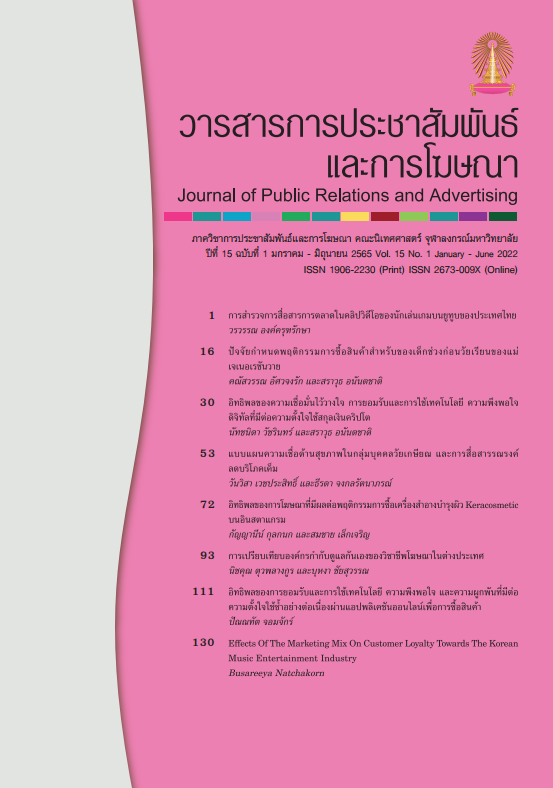ปัจจัยกําหนดพฤติกรรมการซื้อสินค้าสําหรับของเด็กช่วงก่อนวัยเรียนของแม่เจเนอเรชันวาย
Main Article Content
บทคัดย่อ
การวิจัยในครั้งนี้ มีวัตถุประสงค์เพื่อศึกษาอิทธิพลของปัจจัยกำหนดพฤติกรรมการซื้อสินค้าสำหรับเด็กช่วงก่อนวัยเรียนต่อความตั้งใจซื้อของแม่เจเนอเรชันวาย โดยเป็นการวิจัยเชิงสำรวจ และใช้แบบสอบถามในการเก็บข้อมูลจากกลุ่มตัวอย่างแม่เจเนอเรชันวายในกรุงเทพมหานคร ที่มีอายุ 26-43 ปี และมีบุตรช่วงก่อนวัยเรียน อายุ 2-5 ปี จำนวน 613 ชุด ผ่านช่องทางออนไลน์ ผลการวิจัยพบว่า ปัจจัยกำหนดพฤติกรรมการซื้อสินค้าทั้ง 4 ปัจจัย ได้แก่ ปัจจัยส่วนบุคคล (บุคลิกภาพ และการหาข้อมูล) ปัจจัยทางจิตวิทยา (แรงจูงใจ และทัศนคติต่อการซื้อ) ปัจจัยทางสังคม (อิทธิพลของกลุ่มอ้างอิง และอิทธิพลของการบอกต่อผ่านสื่ออิเล็กทรอนิกส์) และปัจจัยทางวัฒนธรรม (ความเป็นคติรวมหมู่) ล้วนมีความสำคัญต่อการซื้อสินค้ารถเข็นเด็ก (สินค้าประเภทเน้นประโยชน์ใช้สอย) และเสื้อผ้าเด็ก (สินค้าประเภทเน้นความเพลิดเพลินทางอารมณ์) นอกจากนั้น ผลการศึกษาอิทธิพลของปัจจัยกำหนดพฤติกรรมการซื้อทั้ง 4 ปัจจัยต่อความตั้งใจซื้อสินค้า พบว่า บุคลิกภาพแบบไม่มั่นคงทางอารมณ์มีอิทธิพลเชิงลบต่อการซื้อสินค้าทั้งสองประเภท ในขณะที่การหาข้อมูล ทัศนคติต่อการซื้อ และอิทธิพลของกลุ่มอ้างอิงด้านค่านิยมในการแสดงออก มีอิทธิพลเชิงบวกต่อความตั้งใจซื้อสินค้าทั้งสองประเภท
Article Details
เอกสารอ้างอิง
จันทิมา สุขเกิด. (2558). ปัจจัยที่ส่งผลต่อการตัดสินใจซื้อนมผงสำเร็จรูปสำหรับทารกแรกเกิดถึงหนึ่งปีของสตรีเจนเนอเรชั่นวาย. วิทยานิพนธ์ปริญญามหาบัณฑิต สาขาวิชาบริหารธุรกิจ มหาวิทยาลัยศิลปากร.
ณัฏฐพร ศุภสรรพตระกูล และชุติมาวดี ทองจีน. (2561). ปัจจัยที่มีอิทธิพลต่อการตัดสินใจซื้อเสื้อผ้าเด็กในกรุงเทพมหานคร. วันที่เข้าถึงข้อมูล 6 กุมภาพันธ์ 2563, แหล่งที่มา http://eprints.utcc.ac.th/6024/1/proceeding_0101%20%E0
%B8%93%E0%B8%B1%E0%B8%8E%E0%B8%90%E0%B8%9E%E0%B8%A3.pdf
The Asianparent. (2561). เผยผลสำรวจพฤติกรรมแม่ ชอบช้อปออนไลน์และเป็นผู้ทรงอิทธิพลในบ้าน. วันที่เข้าถึงข้อมูล 3 มีนาคม 2563, แหล่งที่มา https://th.theasianparent.com/
The Standard Team. (2561). Gen Y กับการเลือกซื้อคอนโดฯ เมื่อที่อยู่ไม่ใช่ที่ไหนก็ได้ แต่ work-life balance ก็ต้องดีด้วย. วันที่เข้าถึงข้อมูล 29 มกราคม 2563, แหล่งที่มา https://thestandard.co/maru-gen-y-work-life-balance/
ธนัทอร นาราสุนทรกุล. (2558). กลยุทธ์ทางการตลาดในมุมมองของผู้บริโภค: กรณีศึกษาวิสาหกิจขนาดกลางและขนาดย่อมผลิตภัณฑ์สาหรับเด็ก. วิทยานิพนธ์ปริญญามหาบัณฑิต สาขาวิชาการบริหารเทคโนโลยี มหาวิทยาลัยธรรมศาสตร์.
นภวรรณ คณานุรักษ์. (2555). การตลาดสำหรับแม่และเด็ก: กระบวนการตัดสินใจจองผู้บริโภคสี่ตาสี่ขาและอิทธิพลของเด็กที่มีต่อแม่. วันที่เข้าถึงข้อมูล 3 มีนาคม 2563, แหล่งที่มา http://www.tpa.or.th/publisher/pdfFileDownloadS/qm173_p71-73.pdf
มาร์เก็ตบัซซสำรวจเสียงจากคุณแม่แท้ๆ. (2560, 9 สิงหาคม). วันที่เข้าถึงข้อมูล 3 มีนาคม 2563, แหล่งที่มา https://www.
matichon.co.th/lifestyle/tech/news_623700
Marketeer. (2561). ตลาดของใช้สำหรับเด็กเป็นอย่างไร ในวันที่เด็กเกิดน้อยลง. วันที่เข้าถึงข้อมูล 3 มีนาคม 2563, แหล่งที่มา https://marketeeronline.co/archives/69581
ศูนย์วิจัยกสิกรไทย. (2562). SME แบ่งเค้กก้อนโต ตลาดสินค้าแม่และเด็ก. วันที่เข้าถึงข้อมูล 3 มีนาคม 2563, แหล่งที่มา https://
www.kasikornbank.com/th/business/sme/KSMEKnowledge/article/KSMEAnalysis/Documents/Child_ProductMarket.pdf
Assael, H. (2004). Consumer behavior: A strategic approach. Boston, MA: Houghton Mifflin.
Bearden, W. O., Netemeyer, R. G., & Teel, J. E. (1989). Measurement of consumer susceptibility to interpersonal influence. Journal of Consumer Research, 15(4), 473-481.
Belleau, B. D., Summers, T. A., Xu, Y., & Pinel, R. (2007). Theory of reasoned action: Purchase intention of young consumers. Clothing & Textiles Research Journal, 25(3), 244-257.
Bhatai, V. (2018). Examining consumers’ attitude towards purchase of counterfeit fashion products. Journal of Indian Business Research, 10(2), 193-207.
Chang, Y., Ko, Y. J., & Jang, W. (2019). Personality determinants of consumption of premium seats in sports stadiums. International Journal of Contemporary Hospitality Management, 31(8), 3395-3414.
Feigelman, S. (2016). The preschool years. In R. M. Kliegman, B. F. Stanton, J. W. St. Geme & N. F. Schor (Eds.), Nelson textbook of pediatrics (20th ed., pp. 76-79). Philadelphia, PA: Elsevier.
Forstner, A. M. (2014). First-time mothers and their pre-purchase behavior in regards to baby products: An exploratory research on the relationship between perceived risk, information search behavior and the purchase decision of first-time mothers (Master’s thesis). University of Amsterdam, Amsterdam, The Netherlands.
Hong, P. T. T. (2015). Factors influencing on purchasing formula milk for babies: An empirical research in Hanoi. International Journal of Business Administration, 6(5), 37-43.
Jain, S., Khan, M. N., & Mishra, S. (2017). Understanding consumer behavior regarding luxury fashion goods in India. Journal of Asia Business Studies, 11(1), 4-21.
Jin, B., & Koh, A. (1999). Differences between South Korean male and female consumers in the clothing brand loyalty formation process: Model testing. Clothing and Textiles Research Journal, 17(3), 117-127.
Killoran, E. (2019). Transition to motherhood: A reality check. Retrieved March 3, 2020, from https://www.familylifecanada.com/parenting/reality-check/
Lee, T. D. (2018). Influence of WOM and content type on online engagement in consumption communities: The information flow from discussion forums to Facebook. Online Information Review, 42(2), 161-175.
Lin, L. Y. (2010). The relationship of consumer personality trait, brand personality and brand loyalty: An empirical study of toys and video games buyers. Journal of Product & Brand Management, 19(1), 4-17.
Lin, L. Y., & Chen Y. W. (2009). A study on the influence of purchase intentions on repurchase decisions: The moderating effects of reference groups and perceived risks. Tourism Review, 64(3), 28-48.
Lutz, R. J. (1991). The role of attitude theory in marketing. In H. H. Kassarjian & T. S. Robertson (Eds.), Perspectives in consumer behavior (4th ed., pp. 317-339). Englewood Cliffs, NJ: Prentice Hall.
Nguyen, T., Nguyen, N., Nguyen, T., Phan, T., Bui, L. P., & Moon, H. C. (2019). Investigating consumer attitude and intention towards online food purchasing in an emerging economy: An extended TAM approach. Foods, 8(11), 1-15.
Noble, S. M., Haytko, D. L., & Phillips, J. (2009). What drives college-age generation Y consumers. Journal of Business Research, 62, 617–628.
Oe, H., Sunpakit, P., Yamaoka, Y., & Liang, Y. (2018). An exploratory study of Thai consumers’ perceptions of conspicuousness: A case of luxury handbags. Journal of Consumer Marketing, 35(6), 601-612.
Park, C. W., & Lessig, V. P. (1977). Students and housewives: Differences in susceptibility to reference group influence. Journal of Consumer Research, 4(2), 102-110.
Patterson, P. G., Mandhachitara, R., & Smith, T. (2001). Switching costs as a moderator of service satisfaction processes in Thailand. Journal of International Consumer Marketing, 14(1), 1-21.
Roberts, B. W., & Mroczek., D. (2008). Personality trait change in adulthood. Association for Psychological Science, 17(1), 31-35.
Ryan, R. M., & Deci, E. L. (2000). Self-determination theory and the facilitation of intrinsic motivation, social development, and well-being. American Psychologist, 55(1), 68-78.
Schiffman, L. G., Kanuk L. L., & Wisenblit, J. (2010). Consumer behavior (10th ed.). Upper Saddle River, NJ: Prentice Hall.
Septianto, F., & Chiew, T. M. (2018). The effects of different, discrete positive emotions on electronic word-of-mouth. Journal of Retailing and Consumer Services, 44, 1-10.
Solomon, M. R. (2017). Consumer behavior: Buying, having, and being (12th ed.). Harlow, UK: Pearson.
Sreen, N., Purbey, S., & Sadarangani, P. (2017). Impact of culture,behavior and gender on green purchase intention. Journal of Retailing and Consumer Services, 41, 177-189.
Teimourpour, B., & Hanzaee, K. H. (2011). The impact of culture on luxury consumption behavior among Iranian consumers. Journal of Islamic Marketing, 2(3), 309-328.
Watjatrakul, B. (2020). Intention to adopt online learning: The effects of perceived value moderating roles of personality traits. The International Journal of Information and Learning Technology, 37(1/2), 44-46.


